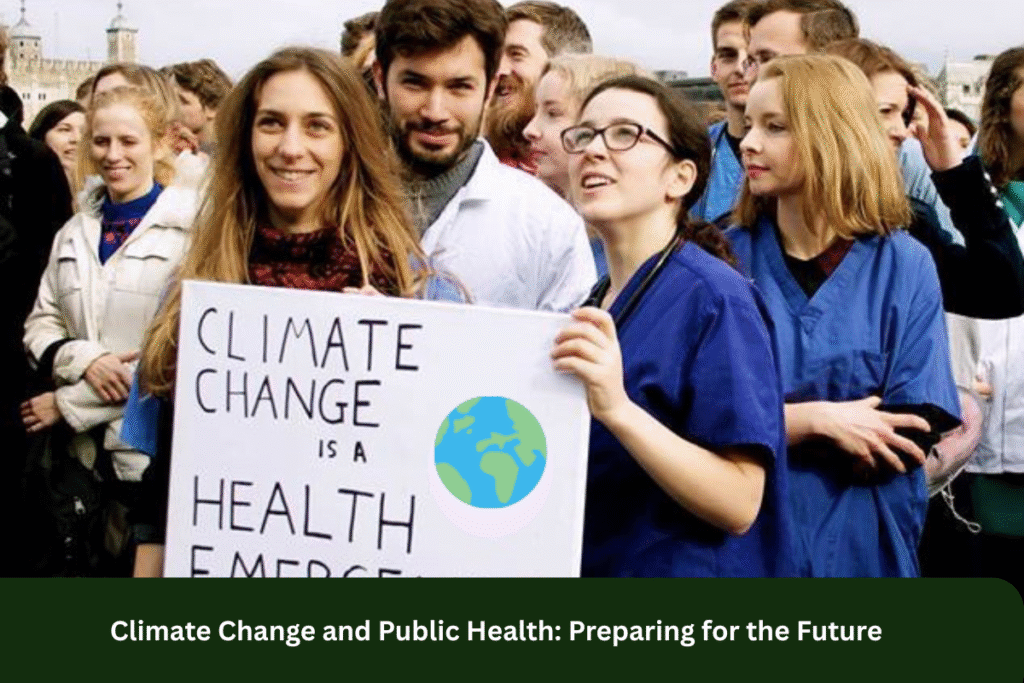
As the effects of climate change continue to unfold, the impact on public health is becoming increasingly apparent. Rising temperatures, extreme weather events, and shifting disease patterns are putting populations at risk, particularly vulnerable communities. The intersection of climate change and public health underscores the urgent need for a coordinated approach to mitigate these effects and prepare for the health challenges of the future. In this article, we will explore the links between climate change and public health, the specific health risks posed by climate change, and strategies to prepare for a healthier future.
1. How Does Climate Change Affect Public Health?
Climate change affects public health in multiple ways, both directly and indirectly. The environmental changes associated with global warming have far-reaching consequences for human health, affecting everything from air quality to food security and disease transmission.
a. Extreme Weather Events
Climate change has led to an increase in the frequency and intensity of extreme weather events, such as hurricanes, floods, heatwaves, and droughts. These events have direct health consequences, including:
- Injuries and deaths: Extreme weather events such as floods, heatwaves, and storms result in injuries and fatalities. For instance, heatwaves can cause heat-related illnesses like heatstroke, which can be fatal if not treated promptly.
- Displacement and stress: Natural disasters often lead to displacement, creating stress, anxiety, and mental health challenges for affected populations. Displaced individuals also face greater risks of infections and inadequate healthcare.
b. Rising Temperatures
Global warming is contributing to rising temperatures, which directly affect public health. Higher temperatures can cause:
- Heat-Related Illnesses: Prolonged exposure to high temperatures can lead to heat exhaustion, heatstroke, dehydration, and exacerbation of pre-existing health conditions like cardiovascular diseases.
- Air Quality and Respiratory Problems: Higher temperatures contribute to the formation of ground-level ozone, a major air pollutant that exacerbates respiratory conditions like asthma and bronchitis. Poor air quality is particularly harmful to children, the elderly, and individuals with pre-existing health conditions.
c. Changing Disease Patterns
Climate change influences the spread of infectious diseases by altering the habitats of vectors such as mosquitoes and ticks. Warmer temperatures and changing precipitation patterns allow these vectors to thrive in new regions, increasing the transmission of diseases such as:
- Malaria and Dengue: Warmer temperatures extend the range of mosquitoes, enabling diseases like malaria and dengue fever to spread to regions previously unaffected.
- Lyme Disease: Ticks, which transmit Lyme disease, are also moving into new areas as a result of changing climate conditions.
- Food and Waterborne Diseases: Climate change affects the availability and quality of water and food, making people more vulnerable to waterborne diseases like cholera and foodborne illnesses caused by contaminated crops and livestock.
d. Impact on Food Security and Nutrition
Climate change has significant implications for food security. Changing weather patterns, droughts, and extreme temperatures disrupt agricultural production, leading to:
- Crop Failures: Droughts and floods can damage crops, leading to food shortages, price increases, and malnutrition, particularly in developing countries.
- Nutritional Deficiencies: The disruption of food supply chains may lead to reduced access to nutritious food, increasing the risk of malnutrition and its associated health impacts.
e. Water Scarcity and Sanitation
Water scarcity is another consequence of climate change, particularly in arid and semi-arid regions. The lack of clean water has a direct impact on public health:
- Dehydration: Water shortages lead to dehydration, which affects overall health, particularly in vulnerable populations like children and the elderly.
- Poor Sanitation: In regions facing droughts or flooding, sanitation systems may fail, leading to the contamination of water supplies and the spread of waterborne diseases.
2. Preparing for the Future: Strategies for Addressing the Health Impacts of Climate Change
To protect public health from the impacts of climate change, it is essential to implement proactive strategies that enhance resilience and reduce health risks. Here are some key approaches:
a. Building Climate-Resilient Health Systems
Health systems must be strengthened to cope with the health challenges posed by climate change. This includes:
- Improved emergency preparedness: Governments and healthcare systems need to be equipped to respond to extreme weather events, ensuring that healthcare infrastructure remains operational during crises.
- Training healthcare professionals: Training healthcare workers to recognize and treat climate-related illnesses, such as heat-related conditions, vector-borne diseases, and respiratory issues, is crucial.
- Expanding healthcare access: Ensuring that healthcare services are accessible to vulnerable populations, particularly those in disaster-prone regions, is key to minimizing health risks.
b. Climate-Smart Agriculture and Food Security
To address the food security risks of climate change, governments and organizations must promote climate-smart agricultural practices. These include:
- Sustainable farming techniques: Encouraging practices like agroforestry, crop rotation, and conservation agriculture helps build resilience to climate impacts and ensures a stable food supply.
- Promoting local food systems: Supporting local, sustainable food production systems reduces dependency on global supply chains and enhances food security in times of crisis.
- Improved water management: Investing in water-efficient technologies, such as drip irrigation, and protecting water resources can mitigate the impact of water scarcity on food production.
c. Mitigating Climate Change and Reducing Emissions
Efforts to mitigate climate change, such as reducing greenhouse gas emissions, can also improve public health outcomes. Key mitigation strategies include:
- Transitioning to clean energy: Shifting to renewable energy sources, such as wind, solar, and hydropower, can reduce air pollution and decrease the health impacts of respiratory diseases.
- Sustainable transportation systems: Investing in public transportation, electric vehicles, and active transport (cycling and walking) reduces carbon emissions and air pollution, improving urban air quality and public health.
- Enhancing energy efficiency: Improving energy efficiency in buildings and industries helps reduce emissions and improves indoor air quality.
d. Increasing Climate Change Awareness and Education
Raising awareness about the health risks associated with climate change and promoting climate literacy can help communities take preventive actions. Public health campaigns, educational programs, and community-based initiatives can empower individuals and communities to adopt healthier, more sustainable lifestyles.
3. FAQs
1. How does climate change impact public health?
2. What is the role of public health systems in addressing climate change?
3. How does climate change affect food security?
4. What are climate-smart agricultural practices?
5. What can individuals do to protect their health from climate change?
4. Conclusion
The impact of climate change on public health is profound and wide-reaching, affecting everything from air quality to food security. Addressing these challenges requires a comprehensive approach that includes strengthening healthcare systems, promoting climate-smart agriculture, and reducing emissions. By taking proactive steps to prepare for the health impacts of climate change, we can protect vulnerable populations and ensure a healthier, more resilient future for all. It’s essential that governments, healthcare systems, and individuals work together to mitigate climate risks and safeguard public health against the evolving challenges of a changing climate.
